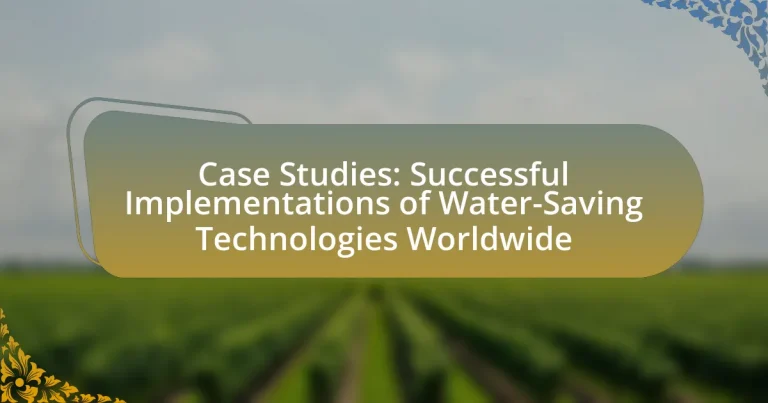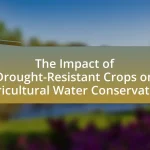The article focuses on successful implementations of water-saving technologies worldwide, highlighting innovative methods designed to reduce water consumption and improve efficiency across various sectors. Key technologies discussed include drip irrigation, rainwater harvesting, greywater recycling, and smart irrigation controllers, which collectively contribute to significant water conservation efforts. The article examines how these technologies function, their key components, and the measurable impacts observed in different regions, including notable case studies from Israel, Singapore, and Cape Town. Additionally, it explores global trends, challenges faced during implementation, and the importance of community engagement and education in promoting these technologies for sustainable water management.
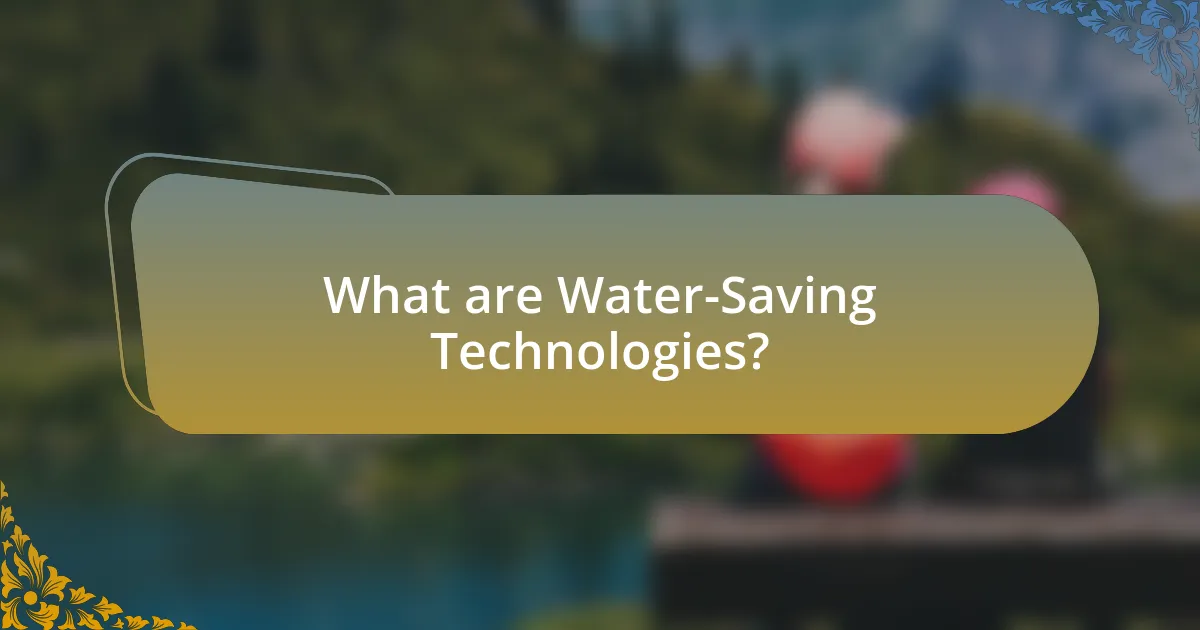
What are Water-Saving Technologies?
Water-saving technologies are innovative methods and systems designed to reduce water consumption and improve water efficiency across various sectors. These technologies include drip irrigation systems, rainwater harvesting, greywater recycling, and smart irrigation controllers, which collectively aim to conserve water resources and promote sustainable water management practices. For instance, drip irrigation can reduce water usage by up to 60% compared to traditional irrigation methods, demonstrating significant efficiency improvements.
How do Water-Saving Technologies function?
Water-saving technologies function by optimizing water usage through various methods such as efficient irrigation systems, rainwater harvesting, and advanced plumbing fixtures. These technologies reduce water waste by employing sensors, timers, and smart controllers that monitor and adjust water application based on real-time needs. For instance, drip irrigation systems deliver water directly to plant roots, minimizing evaporation and runoff, which can lead to water savings of up to 50% compared to traditional methods. Additionally, low-flow faucets and toilets significantly decrease water consumption in households, contributing to overall water conservation efforts.
What are the key components of Water-Saving Technologies?
The key components of water-saving technologies include efficient irrigation systems, rainwater harvesting, greywater recycling, and smart water management systems. Efficient irrigation systems, such as drip irrigation, minimize water usage by delivering water directly to plant roots, reducing evaporation and runoff. Rainwater harvesting captures and stores rainwater for later use, significantly decreasing reliance on traditional water sources. Greywater recycling systems treat and reuse wastewater from sinks, showers, and washing machines for irrigation and toilet flushing, further conserving water. Smart water management systems utilize sensors and data analytics to monitor water usage in real-time, allowing for optimized water distribution and leak detection. These components collectively contribute to significant water conservation efforts, as evidenced by studies showing that efficient irrigation can reduce water use by up to 50% in agricultural settings.
How do these components contribute to water conservation?
Components such as rainwater harvesting systems, drip irrigation, and greywater recycling significantly contribute to water conservation by optimizing water use and reducing wastage. Rainwater harvesting systems capture and store rainwater for various uses, decreasing reliance on traditional water sources and minimizing runoff. Drip irrigation delivers water directly to plant roots, enhancing efficiency and reducing evaporation losses, which can save up to 50% more water compared to conventional irrigation methods. Greywater recycling systems treat and reuse wastewater from sinks and showers for irrigation or toilet flushing, further decreasing overall water consumption. Collectively, these technologies have been shown to reduce water usage by up to 70% in agricultural settings and urban environments, demonstrating their effectiveness in promoting sustainable water management practices.
What types of Water-Saving Technologies are commonly implemented?
Commonly implemented water-saving technologies include drip irrigation, rainwater harvesting systems, greywater recycling, and smart irrigation controllers. Drip irrigation delivers water directly to the plant roots, reducing evaporation and runoff, and can save up to 30-50% more water compared to traditional irrigation methods. Rainwater harvesting systems collect and store rainwater for later use, which can significantly decrease reliance on municipal water supplies. Greywater recycling systems treat and reuse water from sinks, showers, and washing machines, potentially saving up to 50% of household water usage. Smart irrigation controllers utilize weather data and soil moisture levels to optimize watering schedules, leading to further water conservation. These technologies have been successfully implemented in various regions, demonstrating their effectiveness in reducing water consumption.
What are the most effective irrigation technologies?
The most effective irrigation technologies include drip irrigation, sprinkler systems, and subsurface irrigation. Drip irrigation delivers water directly to the plant roots, minimizing evaporation and runoff, and can reduce water usage by up to 60% compared to traditional methods. Sprinkler systems provide uniform water distribution and can be automated for efficiency, while subsurface irrigation places water below the soil surface, further reducing evaporation losses. These technologies have been successfully implemented in various regions, demonstrating significant water savings and improved crop yields, as evidenced by studies showing that drip irrigation can increase agricultural productivity by 20-50% in arid areas.
How do greywater recycling systems work?
Greywater recycling systems work by collecting, treating, and reusing wastewater from sources such as sinks, showers, and washing machines for non-potable applications like irrigation and toilet flushing. These systems typically involve a series of processes including filtration, sedimentation, and disinfection to remove contaminants and pathogens, ensuring the water is safe for its intended use. For example, a study by the Water Research Foundation found that properly designed greywater systems can reduce water consumption by up to 50%, demonstrating their effectiveness in water conservation efforts.
What are the global trends in Water-Saving Technologies?
Global trends in water-saving technologies include the increasing adoption of smart irrigation systems, rainwater harvesting, and wastewater recycling. Smart irrigation systems utilize sensors and data analytics to optimize water usage in agriculture, reducing consumption by up to 50% compared to traditional methods. Rainwater harvesting systems are gaining traction in urban areas, allowing for the collection and reuse of rainwater, which can decrease reliance on municipal water supplies. Wastewater recycling technologies are being implemented in various sectors, including agriculture and industrial processes, enabling the reuse of treated wastewater and contributing to water conservation efforts. These trends reflect a growing global emphasis on sustainable water management practices in response to water scarcity challenges.
Which regions are leading in the adoption of these technologies?
The regions leading in the adoption of water-saving technologies are North America, Europe, and parts of Asia, particularly Israel. North America has implemented advanced irrigation systems and smart water management practices, evidenced by the widespread use of precision agriculture technologies. Europe has adopted stringent water conservation policies and innovative technologies, such as drip irrigation, particularly in Mediterranean countries. Israel stands out for its pioneering work in desalination and water recycling, achieving over 80% of its wastewater being treated and reused. These regions exemplify successful implementations of water-saving technologies through effective policies and technological advancements.
What factors influence the implementation of Water-Saving Technologies worldwide?
The implementation of Water-Saving Technologies worldwide is influenced by several key factors, including economic incentives, regulatory frameworks, technological availability, cultural attitudes, and environmental conditions. Economic incentives, such as subsidies or tax breaks, encourage investment in water-saving technologies by reducing upfront costs. Regulatory frameworks, including water conservation policies and standards, create a legal environment that mandates or promotes the adoption of these technologies. The availability of advanced technologies, such as drip irrigation or smart water management systems, directly impacts the feasibility of implementation. Cultural attitudes towards water conservation can either facilitate or hinder the adoption of these technologies, as communities with strong environmental values are more likely to embrace them. Lastly, environmental conditions, such as water scarcity or climate change, drive the urgency for implementing water-saving solutions, making them more critical in regions facing severe water shortages.
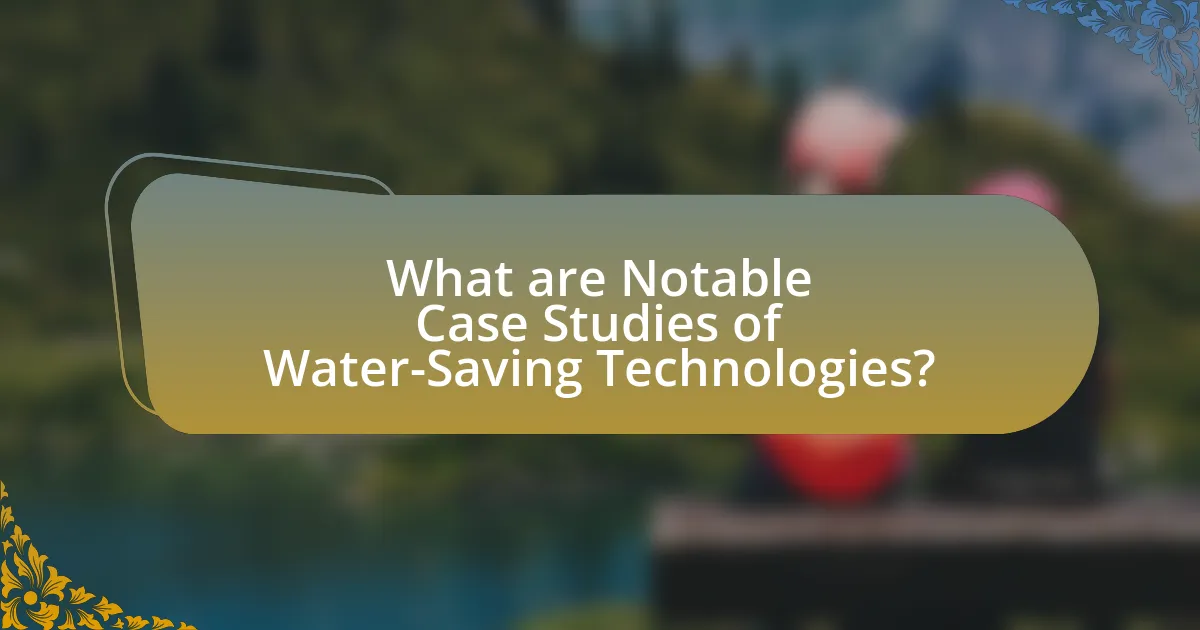
What are Notable Case Studies of Water-Saving Technologies?
Notable case studies of water-saving technologies include the implementation of drip irrigation in Israel, which has increased agricultural efficiency by reducing water usage by up to 60% compared to traditional methods. Another significant example is the use of rainwater harvesting systems in Singapore, which captures and utilizes rainwater to meet up to 30% of the city-state’s water needs. Additionally, the city of Cape Town, South Africa, successfully employed water demand management strategies during its water crisis, achieving a reduction in water consumption by 50% through public awareness campaigns and incentives for reduced usage. These case studies demonstrate the effectiveness of innovative water-saving technologies in addressing water scarcity challenges.
How have cities successfully implemented Water-Saving Technologies?
Cities have successfully implemented water-saving technologies through initiatives such as smart irrigation systems, rainwater harvesting, and wastewater recycling. For instance, San Francisco has adopted a comprehensive water recycling program that treats and reuses wastewater for non-potable purposes, reducing overall water demand by approximately 1.5 billion gallons annually. Additionally, cities like Barcelona have integrated smart irrigation systems that utilize sensors to optimize water usage in public parks, leading to a 30% reduction in water consumption. These implementations demonstrate effective strategies that not only conserve water but also enhance sustainability in urban environments.
What specific technologies were used in these cities?
Cities implemented various water-saving technologies, including smart irrigation systems, rainwater harvesting, greywater recycling, and advanced metering infrastructure. For instance, smart irrigation systems utilize sensors and weather data to optimize water usage in agriculture and landscaping, significantly reducing waste. Rainwater harvesting systems capture and store rainwater for non-potable uses, effectively supplementing municipal water supplies. Greywater recycling systems treat and reuse wastewater from sinks and showers for irrigation and toilet flushing, further conserving water resources. Advanced metering infrastructure allows for real-time monitoring of water consumption, enabling better management and leak detection. These technologies have been successfully adopted in cities worldwide, demonstrating their effectiveness in reducing water consumption and promoting sustainability.
What measurable impacts did these implementations have?
The implementations of water-saving technologies worldwide have led to significant measurable impacts, including a reduction in water consumption by up to 50% in some regions. For instance, in Israel, the adoption of drip irrigation technology has resulted in a 30% increase in agricultural productivity while simultaneously decreasing water usage. Additionally, cities like Cape Town have reported a 25% decrease in water demand due to the implementation of smart water management systems. These statistics demonstrate the effectiveness of water-saving technologies in enhancing water efficiency and sustainability across various sectors.
What lessons can be learned from successful case studies?
Successful case studies in water-saving technologies demonstrate the importance of tailored solutions, stakeholder engagement, and continuous monitoring. Tailored solutions, such as drip irrigation systems, have shown to increase water efficiency by up to 60% compared to traditional methods, as evidenced by implementations in regions like Israel. Stakeholder engagement, including collaboration with local farmers and communities, enhances adoption rates and ensures that technologies meet specific needs, as seen in projects across California. Continuous monitoring and data analysis allow for adjustments and improvements, leading to sustained water savings, as highlighted in case studies from Australia where real-time data has improved irrigation practices.
What challenges were faced during implementation?
During the implementation of water-saving technologies, several challenges were encountered, including high initial costs, resistance from stakeholders, and technical difficulties. High initial costs often deter investment, as seen in case studies where funding limitations restricted the adoption of advanced irrigation systems. Resistance from stakeholders, such as farmers or local communities, can arise due to skepticism about the effectiveness of new technologies, which was evident in projects where traditional practices were deeply entrenched. Technical difficulties, including the need for specialized knowledge and maintenance, were also significant, as demonstrated in instances where inadequate training led to improper use of the technologies. These challenges highlight the complexities involved in successfully implementing water-saving technologies.
How were these challenges overcome?
The challenges in implementing water-saving technologies were overcome through a combination of innovative engineering solutions, community engagement, and government support. For instance, in Israel, the adoption of drip irrigation technology significantly reduced water usage in agriculture by up to 60%, demonstrating the effectiveness of targeted irrigation methods. Additionally, public awareness campaigns and training programs helped farmers understand the benefits and operation of these technologies, leading to widespread acceptance and implementation. Furthermore, financial incentives and subsidies from the government facilitated the transition to these water-saving practices, ensuring that farmers could afford the initial investment. These strategies collectively addressed the barriers to adoption and resulted in successful water conservation outcomes.
What role do community engagement and education play in these case studies?
Community engagement and education are crucial in the case studies of successful implementations of water-saving technologies worldwide as they foster local ownership and understanding of the technologies. Engaging communities ensures that the solutions are tailored to their specific needs and cultural contexts, which increases the likelihood of adoption and sustained use. For instance, in the case study from Israel, community workshops and educational programs led to a 30% increase in the adoption of drip irrigation systems among local farmers, demonstrating that informed communities are more likely to implement water-saving practices effectively.
How can community involvement enhance the effectiveness of Water-Saving Technologies?
Community involvement enhances the effectiveness of water-saving technologies by fostering local ownership and ensuring that solutions are tailored to specific needs. When communities actively participate in the planning and implementation of these technologies, they are more likely to adopt and maintain them, leading to higher usage rates and better outcomes. For instance, a study conducted in California demonstrated that community-led initiatives in water conservation resulted in a 20% increase in the adoption of water-saving practices compared to top-down approaches. This engagement not only promotes awareness but also encourages behavioral changes that are crucial for the long-term success of water-saving technologies.
What educational strategies have proven successful in promoting these technologies?
Educational strategies that have proven successful in promoting water-saving technologies include hands-on training programs, community workshops, and integration of technology into school curricula. Hands-on training programs enable participants to directly engage with water-saving technologies, enhancing understanding and retention of information. Community workshops facilitate knowledge sharing and foster local advocacy for these technologies, leading to increased adoption rates. Additionally, integrating water-saving technologies into school curricula educates students from a young age, creating a foundation for future sustainable practices. Research indicates that communities with active educational initiatives see a 30% higher adoption rate of water-saving technologies compared to those without such programs, demonstrating the effectiveness of these strategies.
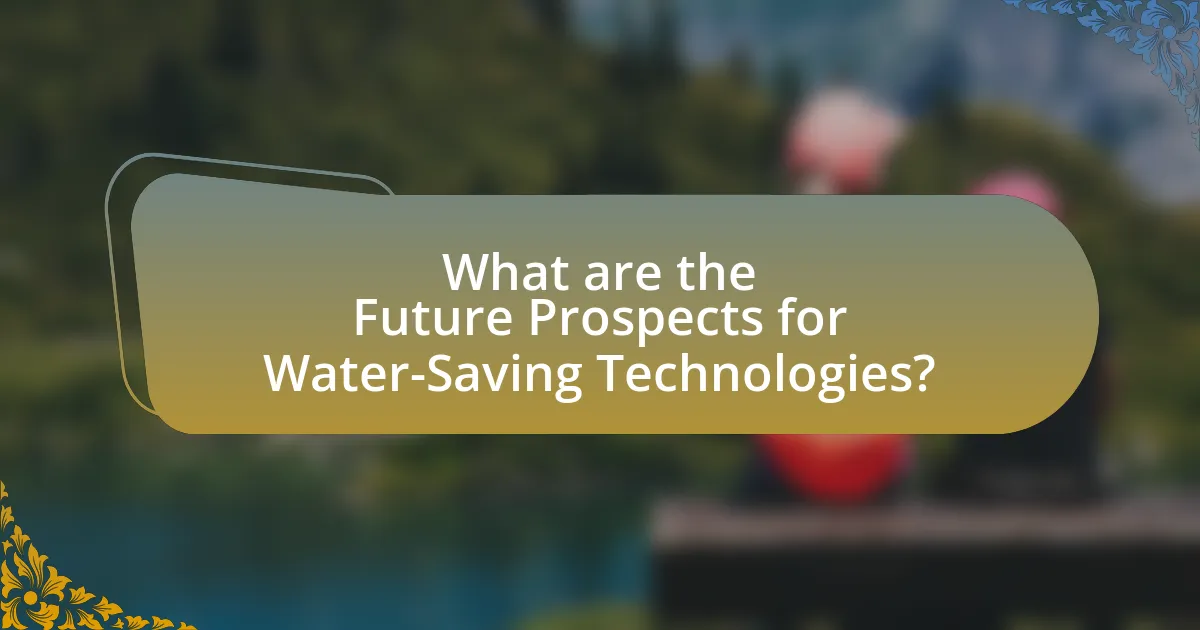
What are the Future Prospects for Water-Saving Technologies?
The future prospects for water-saving technologies are promising, driven by advancements in smart irrigation, water recycling, and efficient plumbing systems. Innovations such as precision agriculture, which utilizes sensors and data analytics, can reduce water usage by up to 50% compared to traditional methods. Additionally, the global market for water-saving technologies is projected to grow significantly, with estimates suggesting it could reach $1.5 billion by 2025, reflecting increasing demand for sustainable water management solutions. These technologies not only enhance water efficiency but also contribute to environmental conservation and economic savings, making them essential for addressing global water scarcity challenges.
How is technology evolving to improve water conservation?
Technology is evolving to improve water conservation through advancements in smart irrigation systems, water recycling technologies, and data analytics. Smart irrigation systems utilize sensors and weather data to optimize water usage, reducing waste by up to 50% compared to traditional methods. Water recycling technologies, such as membrane bioreactors, enable the treatment and reuse of wastewater, significantly decreasing the demand for fresh water. Additionally, data analytics tools analyze consumption patterns and identify leaks, leading to more efficient water management. For instance, cities implementing these technologies have reported reductions in water usage by as much as 30%, demonstrating their effectiveness in promoting sustainable water practices.
What innovations are on the horizon for Water-Saving Technologies?
Innovations on the horizon for water-saving technologies include advanced irrigation systems, smart water management tools, and water recycling technologies. Advanced irrigation systems, such as drip irrigation and precision agriculture, utilize sensors and data analytics to optimize water usage, reducing waste by up to 50% compared to traditional methods. Smart water management tools leverage IoT devices to monitor water usage in real-time, enabling users to identify leaks and inefficiencies, which can lead to a reduction in water consumption by approximately 20-30%. Additionally, water recycling technologies, including membrane bioreactors and advanced filtration systems, are being developed to treat and reuse wastewater, potentially increasing available water supplies by up to 30% in urban areas. These innovations are crucial as global water scarcity continues to escalate, with the UN projecting that by 2025, 1.8 billion people will live in areas with absolute water scarcity.
How can data analytics enhance the efficiency of these technologies?
Data analytics can enhance the efficiency of water-saving technologies by providing actionable insights through data-driven decision-making. By analyzing consumption patterns, predictive analytics can identify areas of excessive water use, enabling targeted interventions that optimize resource allocation. For instance, a study by the International Water Association found that utilities employing data analytics reduced water loss by up to 30% through improved leak detection and management. This demonstrates that leveraging data analytics not only streamlines operations but also significantly contributes to sustainable water management practices.
What are the best practices for implementing Water-Saving Technologies?
The best practices for implementing water-saving technologies include conducting a thorough assessment of water usage, selecting appropriate technologies tailored to specific needs, and ensuring stakeholder engagement throughout the process. A comprehensive assessment helps identify areas of excessive water use, enabling targeted interventions. Technologies such as low-flow fixtures, rainwater harvesting systems, and smart irrigation can significantly reduce water consumption when chosen based on the specific context. Engaging stakeholders, including community members and employees, fosters support and encourages proper usage of the technologies. According to the United Nations, implementing such practices can lead to a reduction of up to 30% in water consumption in urban areas, demonstrating their effectiveness.
What steps should organizations take to ensure successful implementation?
Organizations should conduct thorough assessments of their current water usage and identify specific areas for improvement to ensure successful implementation of water-saving technologies. This involves analyzing existing systems, engaging stakeholders, and setting clear, measurable goals. For instance, a study by the International Water Management Institute highlights that organizations that establish baseline water usage data and involve employees in the planning process achieve higher success rates in technology adoption. Additionally, providing training and ongoing support for staff enhances the effective use of new technologies, as evidenced by case studies showing improved outcomes in organizations that prioritize employee engagement and education.
How can ongoing maintenance and evaluation improve outcomes?
Ongoing maintenance and evaluation can significantly improve outcomes by ensuring that water-saving technologies operate at optimal efficiency and adapt to changing conditions. Regular maintenance prevents system failures and prolongs the lifespan of the technology, while continuous evaluation allows for the identification of performance gaps and areas for improvement. For instance, a study by the International Water Management Institute found that consistent monitoring of irrigation systems led to a 20% increase in water use efficiency in agricultural settings. This demonstrates that proactive management directly correlates with enhanced performance and resource conservation.
What practical tips can be applied to maximize the benefits of Water-Saving Technologies?
To maximize the benefits of water-saving technologies, implement regular maintenance and monitoring of systems to ensure optimal performance. Regular checks can identify leaks or inefficiencies, which, according to the U.S. Environmental Protection Agency, can save up to 10% of water usage when addressed promptly. Additionally, integrating smart technology, such as sensors and automated irrigation systems, can enhance water management by providing real-time data and reducing waste. Research from the International Water Association indicates that smart irrigation can reduce water consumption by 30-50%. Lastly, educating users about the technologies and their proper use can lead to more effective water conservation practices, as informed users are more likely to utilize these systems efficiently.
